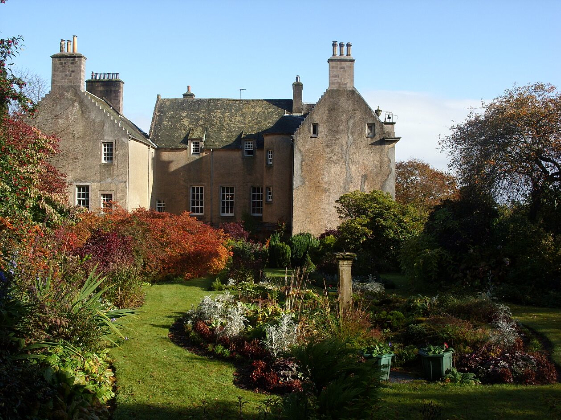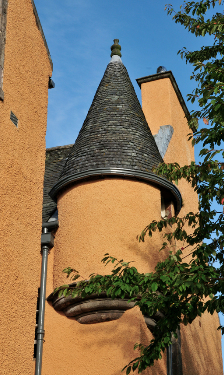 |
A History of Gargunnock
 Westbound out of the historic
city of Stirling the A811 road to Loch Lomond parallels the south bank of the
River Forth as it meanders around the moors and carse lands which are but
remnants of what onetime was a heavily forested valley, part of the ancient
Caledonian Forest. Four miles from the city, at West Carse, the road veers to the
north-west along the "New Turnpike Road", a Military Road constructed in the wake
of the 1745 Jacobite Rebellion, which was opened in 1759 and by-passes the
village of Gargunnock. Westbound out of the historic
city of Stirling the A811 road to Loch Lomond parallels the south bank of the
River Forth as it meanders around the moors and carse lands which are but
remnants of what onetime was a heavily forested valley, part of the ancient
Caledonian Forest. Four miles from the city, at West Carse, the road veers to the
north-west along the "New Turnpike Road", a Military Road constructed in the wake
of the 1745 Jacobite Rebellion, which was opened in 1759 and by-passes the
village of Gargunnock.
All that remains of the "Great Road to Stirling", that ran
through the centre of the village, is a track running across the field to Redhall
where it intersects with a country lane which leads to the village church.
Originally the "Great Road to Stirling" ran through the policies of Gargunnock
estate in a north westerly direction, from a point where the Lodge now stands,
sweeping in an arc past the south-west corner of Gargunnock House prior to
heading out westwards towards the village. Sometime around 1740 a new road to the
village was constructed, running directly westwards from the Lodge, and the old
road from the Lodge to the House was re-aligned to form the Main Drive. Midway
along its length the new South Drive diverged and ran towards the village.
Gargunnock also has a rich historical background, which is inextricably entwined
with the evolvement of the Estate, design landscape and gardens.
The Years up to 1675:
Reminders of "Braveheart" are all around us; to
the North of the House, close by River Forth is the "Peel of Gargunnock", a peel
tower built to guard the ford over the river, that was captured by the English
invaders during the early stages of the War of Scottish Independence. It was soon
taken from the English in 1297 by William Wallace who mounted an attack on the
stronghold, vanquished the enemy garrison and demolished the peel tower.
Immediately to the south of village, in the lee of the Gargunnock Hills, is a
rampart known as Kier Hill where Wallace is said to have posted himself during
the skirmishes.
Wallace advanced eastwards to defeat the English army on 13th
December 1297 at the Battle of Stirling Bridge and become ruler of Scotland. This
vicinity formed the theatre of some of the most brilliant achievements of William
Wallace whose is memorial is the striking pinnacled monument that stands sentinel
on Abbey Craig to the north of Stirling Bridge. Legend has it that those who fell
in the Battle of Ballochleam, fought to the west of Gargunnock, were buried close
by in the grounds of Boquhan Estate, a tale perhaps not without substance as
bones and relics were unearthed in the grounds of Boquhan early in the 19th
Century.
 It is said that comparatively little is known about Wallace's background
and equally intriguing is the lack of detail relating to the early years of Gargunnock Estate. In 1470 the lands of Gargunnock were owned by Alexander
Hepburn, but by 1513 the lands had passed to two owners, Alexander Elphinstone
and Ninian Seton. However, the "lands of Gargunnock" were held throughout the
early 16th Century by the Elphinstones, according
to the Directory of Retours. This suggests that the late-16th Century L-shaped
tower house was constructed by the Elphinstone Family, but this is by no means
certain. It is said that comparatively little is known about Wallace's background
and equally intriguing is the lack of detail relating to the early years of Gargunnock Estate. In 1470 the lands of Gargunnock were owned by Alexander
Hepburn, but by 1513 the lands had passed to two owners, Alexander Elphinstone
and Ninian Seton. However, the "lands of Gargunnock" were held throughout the
early 16th Century by the Elphinstones, according
to the Directory of Retours. This suggests that the late-16th Century L-shaped
tower house was constructed by the Elphinstone Family, but this is by no means
certain.
The Seton Family, one of Scotland's grandest and oldest
Families, held the lands for a little over a hundred years and
also held the nearby Touch Estate from 1420 to 1928. The first
reference to the association of the Setons of Touch with the lands of Gargunnock
was on 22 February 1511/12 when Sir Alexander Seton of Tullibody and Touch
Fraser, second of Touch, had a confirmation under the Privy Seal of that date of
a charter by Sir Robert Colville of Ochiltree, granting him five mercates of the
lands of old extent of Gargunnock, together with the tower, fortalice and
mansionhouse, lying in the Sheriffdom of Stirling.
The next reference is in 1530/31 when a "natural son" of Sir Alexander Seton of
Touch is styled "John Seytoun of Gargunnock", and a precept of legitimation was
issued in his favour.It is certain that it was this John Seton who married Janet
Turnbull, one of the two co-heiresses of Gargunnock. On 23 November 1515 they
had a charter under the Great Seal; 'in conjunct fee, "of the fourth part of the
lands and mill of Gargunnock" and other lands, which had been resigned by Janet
Turnbull. They were, in later charters, styled "portioners of Gargunnock", and
from them descended the first Setons'
of Gargunnock line. They had a son John, and by
charter dated Stirling 19th January 1534/5, they surrendered to him "half the
lands and barony of Gargunnock" reserving, as usual, the frank tenement thereof.
This
transaction applied only to the quarter of the whole estate. John Seton,
younger, married Janet or Helen Callander, and had a charter of the lands in
conjunct fee, in 1536.
On 27th August 1547 John, who had succeeded to his father's part of the lands,
sold them to his nephew Sir Walter Seton of Tullibody who thus had not -only
John Seton's share of a quarter of Gargunnock, but the 5 mercates he had
inherited from his grandfather.
Subsequently John Seton inherited from his aunt, Elizabeth Turnbull, wife of
William Elphinstone, her share of Gargunnock, on 20th June 1557. Sir Walter
Seton's Gargunnock lands passed in due course to his grandson John Seton of
Touch, but his brother Alexander Seton, who became Lord Kilcreuch and was head
of the family of Seton of Abercorn - was styled "apparent of Gargunnock" in
1569; obviously having some interest in the estate. On 11th June 1612 Alexander
purchased the lands from his brother, and was, for a time, styled "of Gargunnock."
Finally, on 22 June 1624, Alexander sold them to John second Earl of Mar; and so
they passed out of the family.
Sir Alexander
Seton of Gargunnock, Lord Kilcreuch, also acquired Culcreuch Castle in 1624 in settlement of monies owed
him by his brother-in-law, Robert Galbraith, 17th Chief of that Clan who was forced to flee to Ireland, bankrupt, to
escape his debts. Later the
same year, Alexander Seton was appointed a judge and took the title
Lord Kilcreuch. Soon his successful career necessitated selling the
estate to be nearer Edinburgh and in 1632, eight years after purchasing
Culcreuch, he sold Culcreuch out to Robert Napier. In 1634 the
Gargunnock Estate is said to have been granted to the Earl of Mar and,
in around 1675, passed to Sir James Campbell, 11th Laird of Ardkinglas, through
marriage to Margaret of Gargunnock.
|

